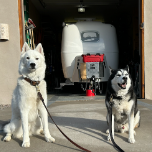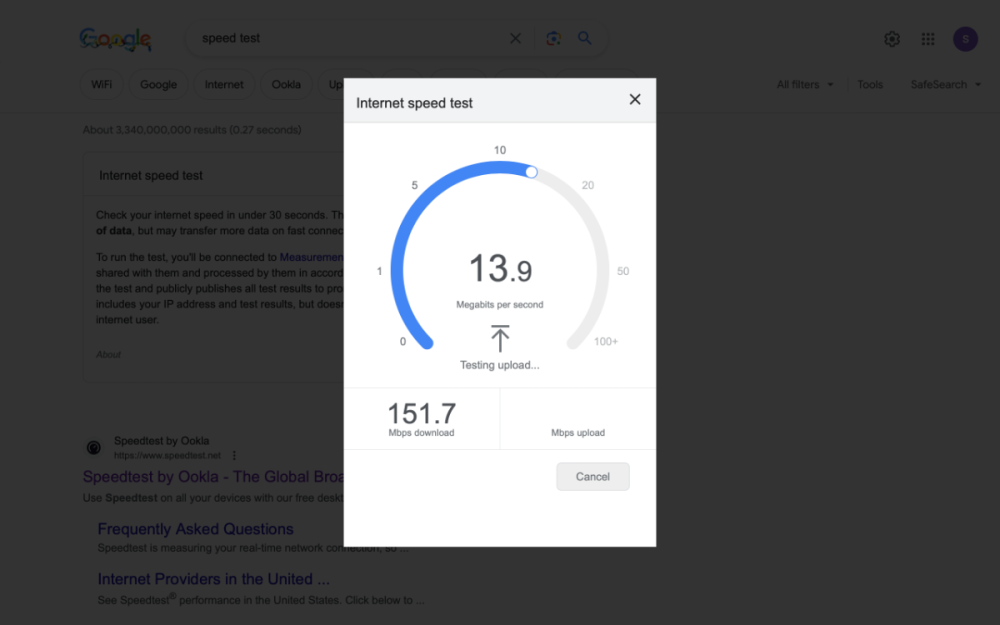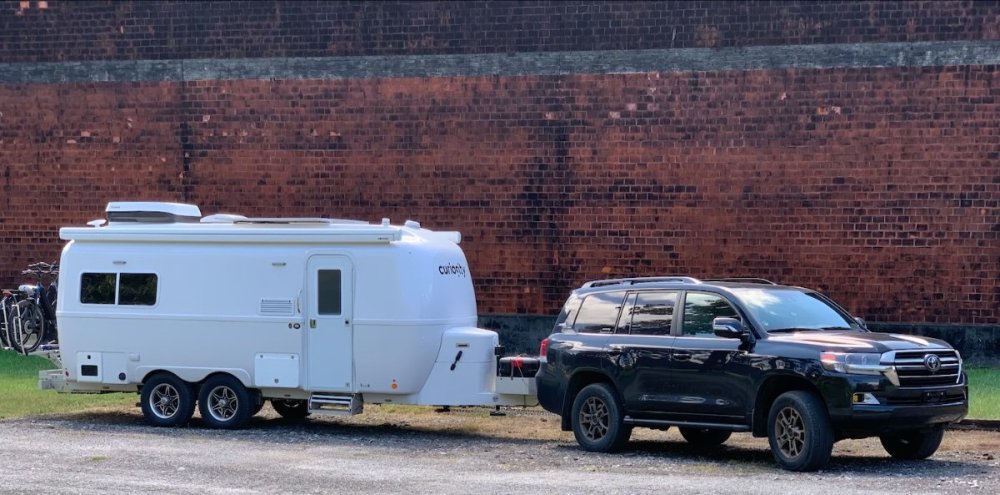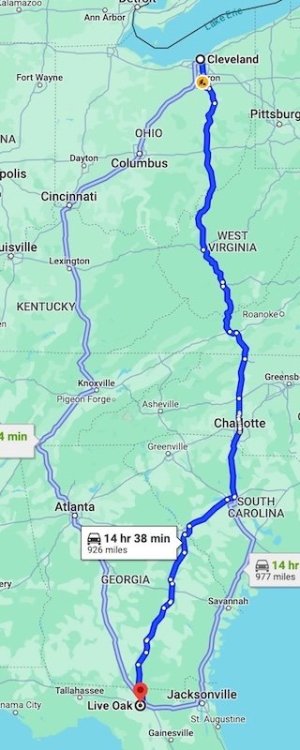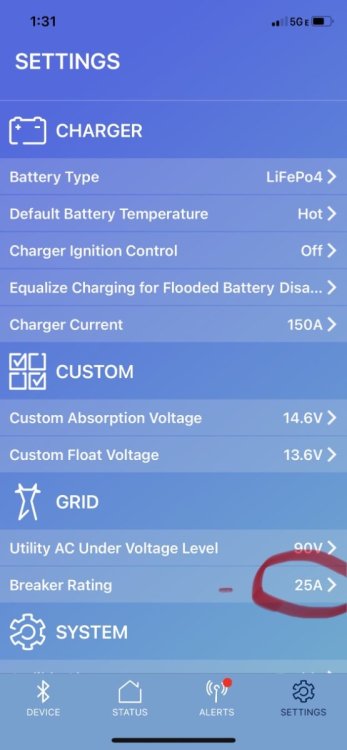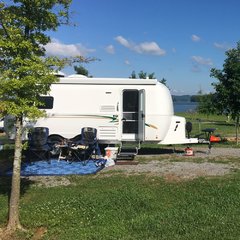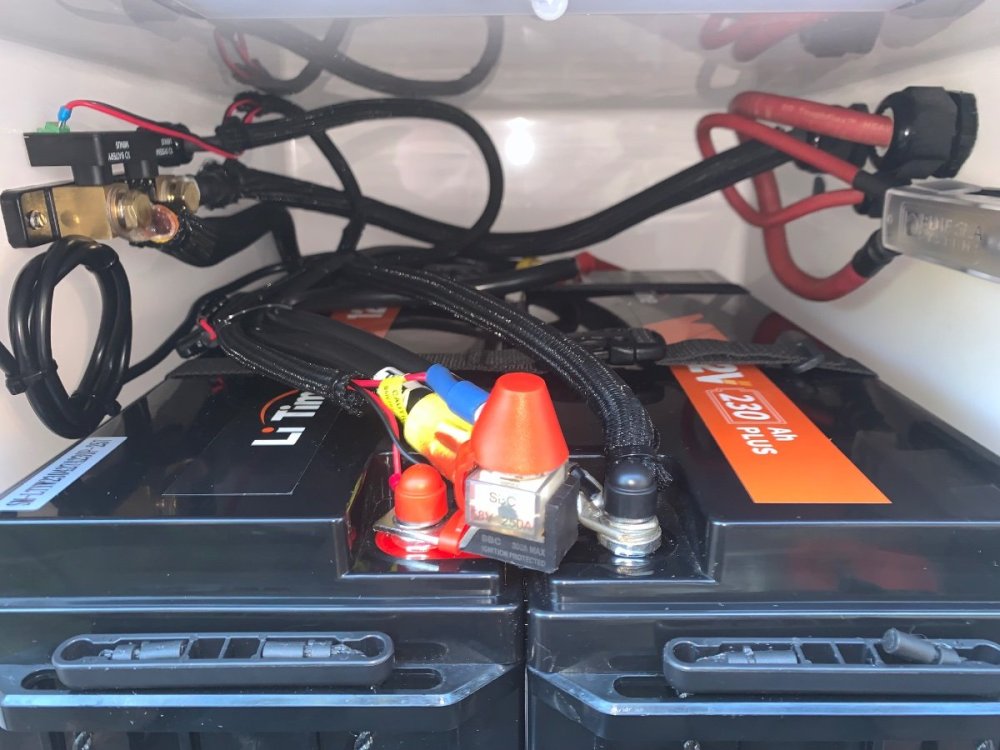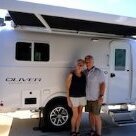Leaderboard
Popular Content
Showing content with the highest reputation on 12/24/2023 in all areas
-
The new Starlink Gen-3 system is out, and it works great! I got one early because Starlink did a special invitation for Gen-1 users only, but now they are available for mobile accounts too. So here are my thoughts on some of the great new features and disappointments that are important for mobile users: 1. Gen-3 uses RJ45 connectors, and it works perfect with the Oliver installation described in my “Don’t cut your Starlink Cable” post. I had previously, and incorrectly, assumed that all Starlink’s systems used RJ45 connectors because thats what my Gen-1 dishy and Gen-3 router had. But alas, the far more common Gen-2 systems did not. Hmmm… that explains why Gen-2 users can’t use the upgraded Gen-3 routers. 2. The Gen-3 dishy is bigger than Gen-2 and it has a wider sky view. I’m not going back on the roof to measure it, but the shipping box is 25 x 15.5 x 3.75 inches to give an idea of the size. I’ve heard complaints that it’s bigger and harder to stow when traveling. In my opinion it’s way easier to stow because It has a convenient fold-up kickstand that eliminates the bulky tripod that came with older dishy’s. I really hated that tripod, it took up as much room as my BBQ. 3. The Gen-3 dishy has no motors or other moving parts, which should be more robust for the rigors of mobile use. 4. The Gen-3 power consumption is 195 watts per the label. That’s higher than Gen-1 (185w) and Gen-2 (about 65w.) This is not great news for boondockers. 5. Starlink still doesn't have a DC power option as many hoped. It has a separate 110v AC power supply with a 57vdc output (3.42amp) and a standard DC power connector. I’m sure someone will soon come up with a 12 to 57vdc volt power supply that can handle that wattage. 6. The Gen-3 router has longer WiFi range and it supports Mesh Node. Of course, the farther away from the router you get, the weaker the WiFi signal gets, and slower the internet speed gets. The Gen-3 router really helps with that. I’ve had a Gen-3 router on my Gen-1 dishy for a few months now and it made a huge difference in internet speed throughout the house. The Mesh feature allows you to add Nodes, sort of like radio relays, that give even further WiFi range, which is a good way to make new friends at camp. 7. The Gen-3 dishy comes with a built-in fold down kick stand designed to sit on a level surface. A pole mount option can be bought separately. You have to use the Starlink App during set-up to get it manually pointed in the right direction. I put mine on the peak of my roof facing West, and tilted it on the sloped roof to approximately match what the kickstand tilt would be if placed on a flat surface. The Starlink App liked the direction it was pointed, but it made me adjust the tilt a few degrees upwards before it would connect to the satellites. I don’t know if there is a work-around for that, but it might be a concern for fixed flat surface mounting such as an RV roof, and for the direction the vehicle is facing. From my almost 3 years of RV experience with Starlink, a fixed dishy mounting is not ideal. You need the flexibility to move the dishy around to find a clear sky view, so its going to be sitting on the ground a lot of time if you want to get a satellite signal. In conclusion, with its wider sky view, built-in kickstand, and the ability to lengthen the cable with a store bought RJ45 cable, I like the Gen-3 despite it’s short comings.6 points
-
To all my friends and the whole Oliver family tree: Merry CHRISTmas and a Partridge In A Pear Tree…6 points
-
6 points
-
Yes, thank you @Patriot for starting this post! I thought I would see a holiday thread here, so I stopped in to see. Merry Christmas and Happy New Year to all OO and families! We're very happy to be Oliver Owners too, just past our 6-month anniversary! The next 6 months, we'll do less learning and fixin' and more getting out on the road. Hopefully a New Years week outing will work out for us and if any of you will be in Quartzite in Feb, we'll haul down the mountain to meet you! Equally happy to be part of this forum and getting to know y'all! Ho-Ho-Ho5 points
-
Wishing everyone a very Merry Christmas and a Happy and Prosperous New Year! Enjoy the Oliver video! Mr and Mrs Patriot🇺🇸🎅🏻🧑🏻🎄4 points
-
Merry Christmas Eve from Farmersville, TX! D, the boys, and I've been here for a week now - it's been raining about 50% of the time. In fact, the rain started last night around 2230 and has yet to stop. Glad to report that "Casa Blanca" is dry as a bone inside. We've kept the bathroom window and ceiling fan vent open (fan not running) and the MaxxAir fan blowing in "Air Out" mode at 10% RPM: result - absolutely no condensation on windows or bulkheads! Right now, enjoying some breakfast wine while D's learning how to crochet... HO, Ho, ho! Cheers, All! @topgun2:PS - Bill, just "Ravel'n On", Ha! TKX!4 points
-
Does this clear the P-traps in the kitchen sink, bathroom sink and shower drains?4 points
-
Merry Christmas and Happy New Year everyone!!! My wish for the new year is safe travels for all and many camping trips this coming year. Looking forward to catching up with friends and making new ones this coming year!4 points
-
Merry Christmas to All in the Oliver Family... May 2024 bring in Peace, Happiness, and Prosperity to us all Cheers! A & D4 points
-
4 points
-
Thanks Geoff! I was asking for holes in my procedure, and you found one. IMHO, I feel expansion in a P-trap goes 99% upwards, like an ice cube tray, and has not concerned me. We can add a step 13 to the procedure: 13) Add 3-4 OZ of RV antifreeze to each drain (bath, shower, kitchen) and in the toilet bowl (with water). There is no additional maintenance in this step, as p-traps do not need to be flushed and cleaned later like the freshwater plumbing system. You can drive on and use them as-is. Great addition!3 points
-
Tire pressures will go up as the tires heat up, be it from ambient temperatures or just from running down the road. Ten percent would be a reasonable expectation. I do think you’re on a correct track lowering the pressure. Depending on several variables, 50-60psi should be your range for a late model LE. The vintage early LE’s were somewhat lighter than the ones coming off the line today. Weighing the trailer when it’s full of fresh water and all camp supplies that would normally be on board is a good way the get an accurate weight to base your tire pressures on.3 points
-
Merry Christmas everyone! Hoping for a New Year full of travel and camping for everyone! Nice bottle of Amber Falls wine in the video, they are a HH if you want to do serious tasting then just walk back to your Oliver! Mike3 points
-
Not necessarily due to the many variabilities involved. For the vast majority of TV's being used for OE2's, the charge current is not limited by the factory alternator size when charging up to 30 amp units like the Victron- Orion 12-12/30 amp unit size. Rather, I believe that the main limiting factor is the cable size driven voltage drop. For our size of rigs, the absolute minimum I would suggest using is 4 AWG. I also prefer running two parallel cables vs. using chassis grounding. For those using Litho's and/or having a Smart Shunt on the negative side, the only thing connected to the battery bank is the shunt. I believe OTT knows this and would be "Shocked" if they had not wired their Litho systems accordingly. Beyond this imperative we could have a discussion about wiring various other charging systems.... actually the topic of a thread or two. 😉 I'll leave the first part of this response to others to debate. However, the bolded part tosses a red flag in my pea brain. At a basic level, the PRIMARY purpose of the shunt is to MEASURE charge current and battery draw for the purpose of calculating the battery bank SOC. Whereas the solar controllers CONTROL the charge rate and doing so properly does impact battery life. Not the shunt. Granted using additional equipment may aggregate data for display and other purposes. But the basic equipment purposes remain the same.2 points
-
Woah! That's a boat-load of cash riding down the road on 6 wheels! SHEESH!2 points
-
2 points
-
Confirmed! You worked this out in one day, a question many fear, deliberate over for years! Like both @ScubaRx and I mentioned, weigh your trailer to be sure where you fit on the table. Yes, these numbers are for each tire. The 65 PSI you were told will handle the Elite I, on these tires, at full GVWR of 5000 LBS. Water weighs 8.33 LB/Gal, a 30-gallon tank comes to 250 LBS. A packed fridge, closets, pantry and other cabinets can hold a bit of weight too. I weighed ours coming back from a short camping trip, before we unpacked. I added 250 LBS for fresh water used (we had drained Black and Gray tanks) and 100 LBS for food and drinking water consumed. Mine came to 6000 LBS total on an Elite II, so we can run at 45 PSI. However, there is more weight/tire on the Elite I.2 points
-
2 points
-
“Towing with electric vehicles is a fraught conversation even though only a minority of Americans actually use their vehicles for towing on any regular basis. Regardless, it has become a goalpost for EV acceptance in the market for some people. By now, it shouldn't be news that towing with an EV reduces range, just as it does when towing with a combustion-powered vehicle. It shouldn't surprise you, then, that our new Tesla Model Y doesn't go very far when towing a trailer.” 2023 Tesla Model Y Long Range Yearlong Review: How Far Can You Tow With a Tesla? Nothing earth shattering in the article, but they do provide some interesting range figures. John Davies Spokane WA1 point
-
1 point
-
My point on TV alternators was not re limiting factor. The DC-to-DC chargers drawing 20-30-40A and with 4GA cables can pull a lot of Amps. Is your alternator designed for that? Some have extra capacity, what you may call a HD alternator and some do not. if you're investing the expense of a DC-to-DC system, make sure your alternator is up for the task. Back in the day, I had an alternator give out in an old car while on the Interstate. Didn't know it went out, until I heard a backfire and the engine quit (battery charge got too low to run ignition system). We were lucky and coasted off an exit ramp, pulled into a hotel parking lot, where we spent the night, went to the AP store in the morning! Would hate to be pulling a trailer in this situation. Every alternator is rated for amperage, and if there is a higher capacity model, it's the one you want for DC-to-DC charging. Look up your TV on rockauto.com, replacement parts and further down the list premium parts (usually 2 amperage specs). Those running these chargers should keep their eye on the battery/Alt gauge and if you do not have one, add one. @Geronimo John I agree with your written statements re the purpose of both the Shunt and the Solar Charger (SC). I've always seen them integrated. Look again at my Blue Sky pic above to see what I mean. I believe the SC reads the current draw data from the shunt in their charging algorithms. I may be wrong, but in the two systems I've worked with they are always installed together (perhaps not with Victron where everything is modular). We do need an experienced EE in our group! Check out two PDF files (attachments). I installed a Bogart Engineering BMS and SC on my last RV. One doc simply explains the shunt. The other is for their SC product. Check out page 2 for the wiring diagram. They sell their SC with a shunt. @Ronbrink I'm totally jealous of your battery bay installation, cleaned up the factory install, and everything is so NICE, excellent work! Electrical_Shunts_Explained.pdf SC2030 INSTRUCTIONS_041018.pdf1 point
-
1 point
-
I see now how this thread was split off from another post @Geronimo John started about flexible panels. Like your 'OllieEvolution" story! We totally get it and hence we purchased used to be affordable. Our own Oliver Evolution has been long in only 6 months... We have already added $5K in extras, none of it solar related, but can afford this given our initial cost (new TV A/V system, rebuilt axles, new beds and bedding, improved water pump and electric valves, etc.). Bought a 20-year-old TV too and when I'm done, we will have another $10K into it (already new suspension, wheels, tires, brakes, water pump and timing belt, hoses, all fluids, fuel pressure/temp gauges, tool boxes and water tank, performance chip and next year an exhaust brake). When I get all done, we will have spent 30% the cost of a new diesel 3/4-ton truck. Start small and yes, Evolution! Our solar/battery/inverter setup is good enough for quite a while. LFPs for us will come 4-5 years down the road since our 450 AH of lead acid is only 2 years old. I would like to add the Victron SmartShunt ($130), not thinking we need anything else at this time, but I enjoy reading about everybody's upgrades. I'm thinking I can add the SmartShunt directly at the battery ground like @CnC did for his 712 install, and just leave the Blue Sky shunt as-is (see pic above). What a simple install, since I'm not adding the 712 display, everything is wired within the battery bay with Bluetooth to read battery information. Although, the SmartShunt has a gray lead that can read the TV battery voltage, be attached to a battery temp gauge, and other uses. I could wire this to the black lead, at the +12VDC bus (also shown in pic above), which connects thru the trailer electrical connecter to the TV battery. This should show about 12.6V when sitting and 14V+ with engine running when operating correctly. Just purchased this: Amazon.com: Victron Energy SmartShunt IP65 500 amp Battery Monitor (Bluetooth) : Automotive1 point
-
I had the same thing happen to me at a nearby campground. We pulled in with the lithiums about 50% discharged and plugged into the 30 amp pedestal. Initially everything was fine but then I could hear the xantrex cooling fan turning on and off every 30 secs. I also got a communication error with my xantrex remote panel. I later did a software update on my xantrex and the problem never occurred again. I later learned from the campgrounds website that the 30 amp hookup was rated at 20 amps. I didn’t think it was my ems because it was cycling too quickly. My advice would be to try to reproduce the issue with another power source. Another possible solution would be to decrease the breaker rating on your xantrex phone app to 15 amps from 25 amps.1 point
-
1 point
-
Monitor your power source. You can do this easily by looking at the EMS panel. In our Oliver the panel is in the attic and its readout is in red LEDS. If the voltage drops to around 104V, the EMS will cut off shore power. If the Xantrex is drawing a lot of power (as it will by default when charging your batteries), with an unstable shore power source this could bring down the voltage to the point of EMS shutdown. This removes the power drain and allows the voltage to rise. Once it is sufficient, the EMS cuts back in and eventually powers the Xantrex. The resulting battery charging draw will bring down the voltage, etc., etc. I had this happen to our trailer at a campground that had unstable 30A shore power. Even if your batteries are fully charged, the Xantrex starts off by attempting a full charge and then rapidly changes from Bulk charging to the Absorption stage which draws much less power. You can also reconfigure the Xantrex to charge batteries at a much slower rate so its power draw is not so severe. May help, may not... We have the Lithium Pro package and Xantrex charging is set by default to 150A.1 point
-
Just run the pump while working the procedure. Only if a pump freezes filled 100% with water can it be damaged from the expansion of freezing water. BTW, when y'all get around to up grading your pump, most high-end pumps today can run dry for hours without issue.1 point
-
When using compressed air, and have done that many times on other campers/trailers, I always worried about water left in the pump. With the Oliver, it’s just so easy to use the pink stuff.1 point
-
Because we live in the SW, we do more camping over the winter months, spring and fall of course, and none during summer (think Snowbirds RVing in Quartzite AZ). So, we don't truly "winterize" but live at 5400 FT elevation and it can get COLD overnight. Whenever the weather report forecasts several consecutive nights low 20s or in the teens, I'll blow out the water, but we could be heading out next week! This occurs often, 2-3 times a winter. I could not see adding antifreeze and flushing it clean on this basis. If winterizing the Oliver with antifreeze takes you 20 minutes, then using air should take 10-15 minutes. Yep, you need an air compressor. Mine has a 100' hose so I can fill RV tires all the way out on our road. Good time to check tire pressure and overfill your tires 10% for winter parking. This way when you are ready to leave again all you have to do is check pressure, let a little air out. The real difference is when we are ready to head out, everything is done and ready. No flushing antifreeze, just fill the freshwater tanks at home or at the campsite depending.1 point
-
Not advice 😄 I just never use compressed air. When we recently winterized, it took my wife and I maybe 20 minutes really taking our time. I think Oliver puts their winterization instructions in place to ensure that it’s easier for folks who might not own an air compressor and may not clearly understand that ALL water must be removed from the system lines or diluted with antifreeze. Side note: Tightening the white compression fittings is a regular inspection point for me. If one of those compression fittings is slightly loose, compressed air likely won’t get the rest of the plumbing clear of water. We don’t get long deep freezes here in Western NC, the land of long summers and short winters and I still use AF. All this said, I would never know that I have cleared every bit of water from my lines, so being risk adverse, I choose to use RV safe antifreeze and sleep really well. Surely others will chime in, and if compressed air works, I say go for it! Patriot🇺🇸1 point
-
The Riven does a bit better. But frankly I am surprised that Tesla offers a trailer hitch. None the less, not a suitable TV for our long distance towing with an Ollie. But we can only imagine what will be the case in the future as the battery densities get much better than todays. GJ1 point
-
Wow, lots of good comments here. Thank you @Ronbrink for starting this. Many thoughts to follow... Yep, the rooftop batwing panels detract from appearance, but I would not be without them. It was a cloudy day in AZ yesterday. I was in and out of the Oliver all day, ran the furnace, was testing a water pump install, ALL interior lights on, inverter on, my TV monitor streaming news in the background, and finished the day with a 98% charge. Love this solar setup and all the standard LED lights that draw minimal power. First time I've heard of an RV with a considerable LiFePO4 battery bank not fed by solar! But as @SeaDawg reminded us, we all have different needs. Installing DC-to-DC chargers, make sure your vehicle has a HD alternator! Diesel trucks usually do as the Dodge Ram 2500 Cummins always had one coupled with a dual starter-battery system (setup this way for the electrical demand of adding a snowplow and other heavy draw accessories). Look to see if you have or can purchase a higher output alternator (buy OEM or the best name brand possible). You do NOT want to starve your TV ignition system and ECM of required voltage. I do understand the claim of the DC-to-DC products is that it regulates the draw, but if a HD alternator has more available power, it will charge your house batteries more quickly. Many half-ton trucks will come new with a standard alternator, with a higher amperage model available. An alternator install is normally a half-hour task. In our travels, I like to plan only 2-3 hours driving between stops, so the DC-to-DC charger has less value in our use-case (so many feet of dual 4 AWG COPPER cable makes this a costly upgrade in today's market). Those of you with OTT installed solar wanting additional panels, do NOT count on a cheap panel to have a smart solar charger. Does OTT actually install the exterior solar port wired DIRECTLY to the batteries? No, no, no, this is crazy as it should be wired to the internal solar controller. You can have multiple electrical sources inputted to a solar charger, but you do not want multiple solar charge controllers working in parallel! They could overcharge and how can you monitor current draw and battery life (%)? Many controllers are rated for 30A, as this one from Victron. The Victron design is made to wire multiple units together for 30A-60A-90A... as many as you need (with some design maximum). We are running the OTT installed 25A Blue Sky controller. If I was to install additional panels, adding an exterior bodyside input terminal (like OTT installs), I would replace the Blue Sky with this Victron controller for the solar on the roof and add a second Victron controller for the moveable panels, which would then allow up to 60A total of solar power. Amazon.com: Victron Energy BlueSolar MPPT 100V 30 amp 12/24-Volt Solar Charge Controller : Patio, Lawn & Garden Those of you w/o OTT installed solar, install one of these controllers (or another brand) under the streetside bed. Install a bodyside quick-connect terminal wired to the controller and cabling from the controller to your batteries. Then you can buy ANY solar panel w/o (or bypass) a built-in controller. I've had large rigs and given solar attached we rarely have used a generator, so we're going w/o one (we keep our fire ring in the front bin!). Keep in mind, we live SW and do not summer camp requiring A/C. We have the OTT solar panels, I was told 380 watts, but not sure. We have newer (4) 6v 225AH lead-acid batteries, so this adds up to 450AH at 12VDC (225 AH at 50% discharge). The ample combination of batteries and solar (with accurate monitoring) is key to modern RV life.1 point
-
Well I for one am glad the thread was updated! I'm new to towing, with my new-to-me low-milage 2021 LE l, and just inflated my OEM tires to the sticker pressure (80lbs). After some short trips (4K miles of towing), I got a Tireminder and noticed my tires going up about 10% in pressure while towing. Seemed high to me, so I decided to double check and ran into this and a couple other threads. I'm now running them at 60lbs. It feels much smoother! Thanks for bumping the thread forward! Geoff1 point
-
Yes to all the above by @Frank C We have both filters. The above filter for decalcification summer use, and the other (optional) anti freeze 12v filter for winter travel. @Wandering Sagebrush Is it possible the previous owners may not have purchased the optional winter travel filter? We are really spoiled having the Truma on demand endless hot water, especially when using full hook ups and when it comes time for winterizing.1 point
-
FYI....Just updated our website with pictures to include all the fall stops for the Colorado/Utah and Arizona parks. If interested you can see them here: https://4-ever-hitched.com/fall-2023-%2F-mighty-5 Craig Hull 505 Galway Girl1 point
-
I do just the opposite. I want to minimize our fossil fuel use and maximize the sun. My rationale is that I don't know how long to run the generaor in the morning when the charge is low. So, my guess is never the most percise answer. I do the opposite practice, but for the same reason. I rarely have to use the genset. But, because I monitor our usage, frequently, I know when I need to use the genset, and when fixed solar and portable can do the job, and keep up with the dc fridge. If we're parked in partial shade, and we've had three or four days of gloomy or rainy weather, I know I'm going to have to deploy my Honda 1000. By trial and experience, running it first thing in the morning, so slower solar can deal with the ramp down, I get my best use. Everyone's style is different, and it's really good when we document, as you and I have, what works best for our style, and situations.1 point
-
The Chevy Express/GMC Savana is fine but I suggest getting the 6.6L instead of the 4.3 I think it is V-6. I have the older 4.8L which has similar specs and while it does fine fully loaded by itself, going up hills with a 6000 lb trailer behind it would be a stretch. I checked out the other vans some time ago and the only one I would be comfortable with is the Chevy/GMC...dated but reliable, a good driver, and lots of payload and towing.1 point
-
Not a good choice. The empty dry weight of a bare bones no options Elite II is 4,900 lbs. That’s completely empty with no options at all. We have minimal options (no solar package, no second awning, no front storage basket) and our Elite II has a dry weight of 5,100 lbs on the factory sticker. Loaded up for camping we are close to 6,000 lbs with a full fresh water tank. Some owners are over 6,000 lbs. because of their options and accessories. That RAM towing capacity doesn’t give much of a safety margin.1 point
-
0 points
-
0 points
-
@jd1923 Is the valve with the blue housing a Misol brand or US Solid brand. If it is a US Solid brand the threads will be 1/2" NPT (National Pipe Thread - tapered threads) If it is a Misol brand be aware that the threads may be 1/2" BPT (British Pipe Thread - straight threads) Both of these brands are manufactured in China. I'm pretty sure that neither brand valves are using lead-free brass. However, the US Solid brand does have a SS version available. My original valves have BPT. knowing that there was a slight difference in the thread pitch, I used Teflon tape (several wraps) to make a watertight seal with the 1/2" NPT plastic nipples that I used to join the valves to the rest of the plumbing. I have never had any seeping or leakage, but I wanted you to be forewarned that it might be a good idea to seal those threads well. I like your plan to also be able to control the valves in such a way that you can also use the system to suck antifreeze into the pipes. The use of momentary contact switches is clever as well. The reason I did not include these functions into my system is because I don't use antifreeze here in the Deep South. I just blow out the lines with air pressure and keep a small electric heater going during the colder months (December thru January) to keep the entire trailer including the basement at about 60 degrees. The reason I did not use momentary contact switches is because the electric valves I used do not have any power draw while they are at rest. I have recently installed a compressed air system in the trailer that lets me flip one switch and it opens two electric valves that allows 40psi compressed air into the plumbing system to purge all the lines and the water heater for my minimal "winterization." There are back flow preventer's in the air lines to keep water from entering the air system when in normal use. I also extended the air lines to quick-connects in the wheel wells to make the checking and filling of the tires easier.0 points
-
Recent Achievements


